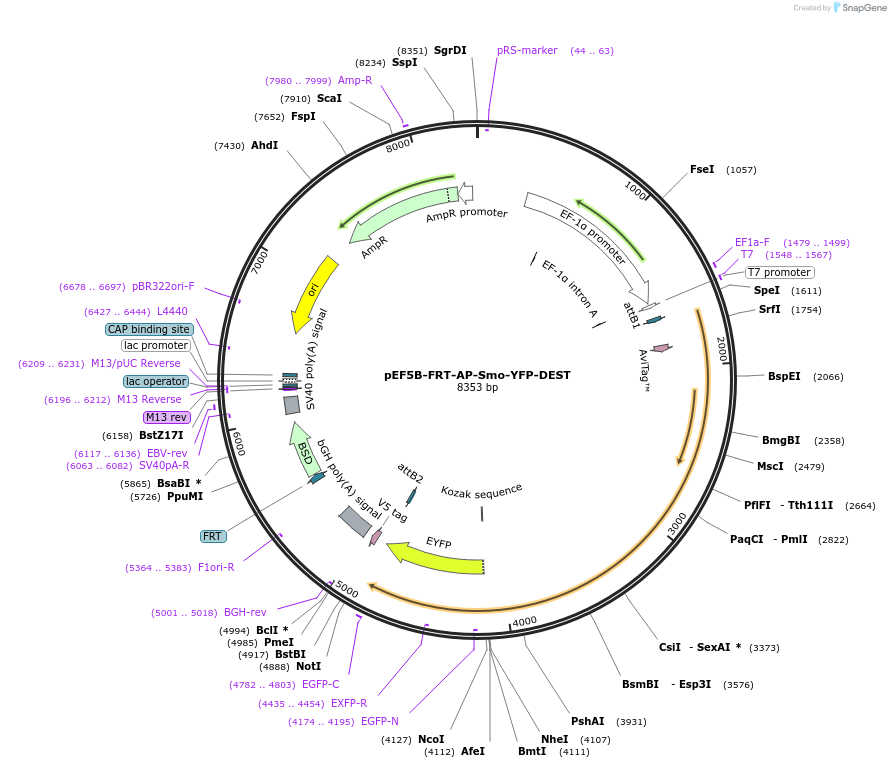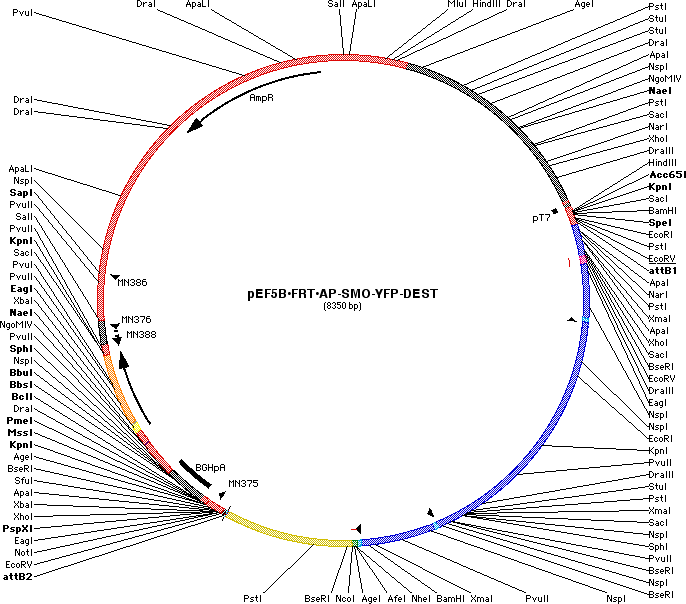pEF5B-FRT-AP-Smo-YFP-DEST
(Plasmid
#49099)
-
PurposeExpressing AP-Smo-YFP in mammalian cells, can be used for establishing Flp-In stable cell lines
-
Depositing Lab
-
Sequence Information
Ordering
| Item | Catalog # | Description | Quantity | Price (USD) | |
|---|---|---|---|---|---|
| Plasmid | 49099 | Standard format: Plasmid sent in bacteria as agar stab | 1 | $89 | |
Backbone
-
Vector backbonepEF5B
- Backbone size w/o insert (bp) 6833
- Total vector size (bp) 8350
-
Modifications to backboneGateway Cloning DEST vector from Life Technologies
-
Vector typeMammalian Expression
-
Selectable markersBlasticidin
Growth in Bacteria
-
Bacterial Resistance(s)Ampicillin, 100 μg/mL
-
Growth Temperature37°C
-
Growth Strain(s)Mach T1
-
Copy numberHigh Copy
Gene/Insert
-
Gene/Insert nameSmo
-
Alt nameSmoothened
-
SpeciesM. musculus (mouse)
-
Insert Size (bp)2408
-
Entrez GeneSmo (a.k.a. E130215L21Rik, Smoh, bnb, smoothened)
- Promoter T7
-
Tags
/ Fusion Proteins
- acceptor peptide (AP) (N terminal on insert)
- YFP (C terminal on insert)
Cloning Information
- Cloning method Gateway Cloning
- 5′ sequencing primer ATGGCCGCTGGCCGCCCC
- 3′ sequencing primer CTACAGCTCGTCCATGCCGAGA
- (Common Sequencing Primers)
Resource Information
-
A portion of this plasmid was derived from a plasmid made byAP-SMO-YFP was a gift from Dr. Carolyn Ott in Jennifer Lipincott-Schwartz lab.
Terms and Licenses
-
Academic/Nonprofit Terms
-
Industry Terms
- Not Available to Industry
Trademarks:
- Zeocin® is an InvivoGen trademark.
These plasmids were created by your colleagues. Please acknowledge the Principal Investigator, cite the article in which the plasmids were described, and include Addgene in the Materials and Methods of your future publications.
-
For your Materials & Methods section:
pEF5B-FRT-AP-Smo-YFP-DEST was a gift from Maxence Nachury (Addgene plasmid # 49099 ; http://n2t.net/addgene:49099 ; RRID:Addgene_49099) -
For your References section:
Single molecule imaging reveals a major role for diffusion in the exploration of ciliary space by signaling receptors. Ye F, Breslow DK, Koslover EF, Spakowitz AJ, Nelson WJ, Nachury MV. Elife. 2013 Aug 6;2:e00654. doi: 10.7554/eLife.00654. Print 2013. 10.7554/eLife.00654 PubMed 23930224







